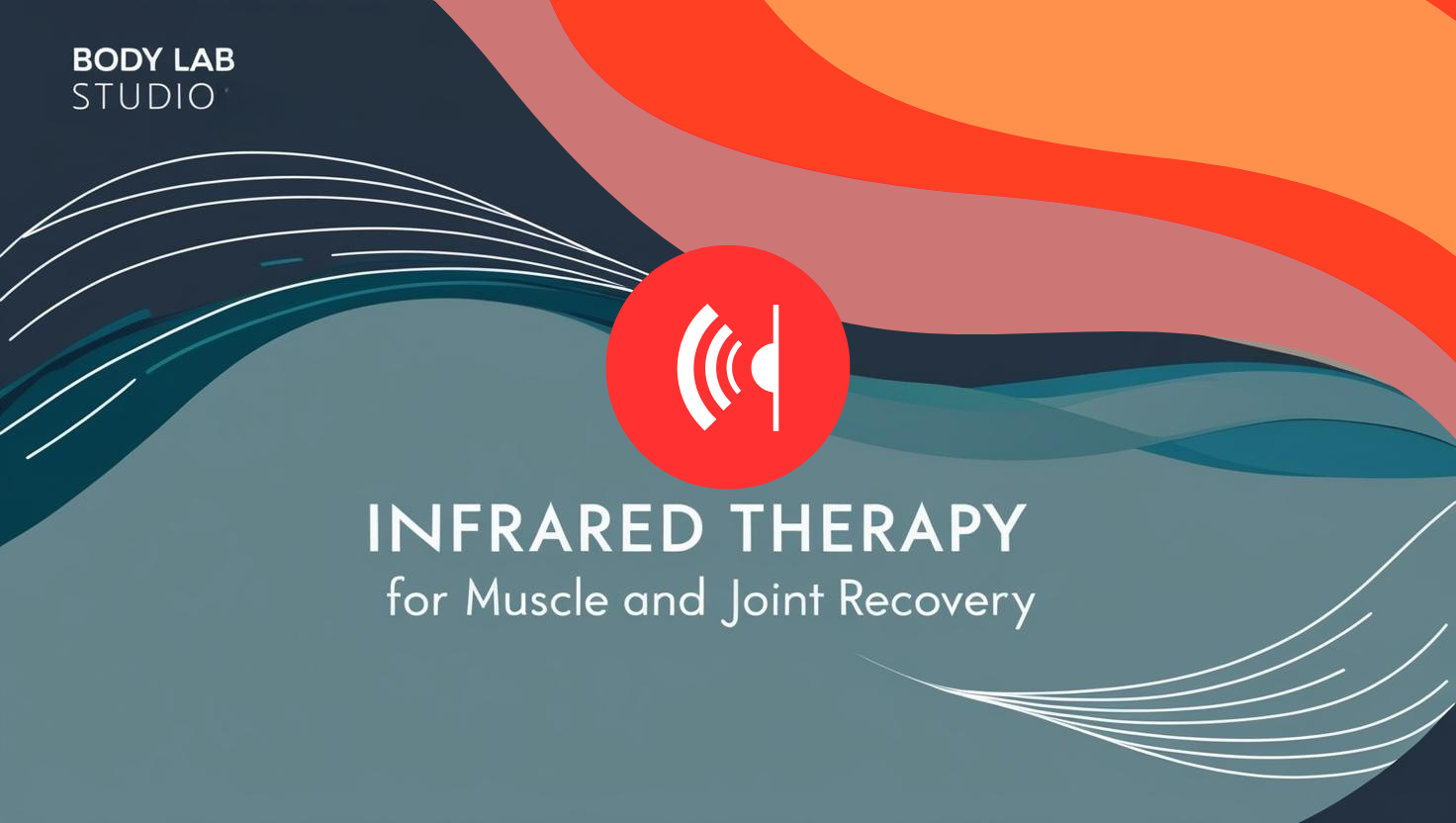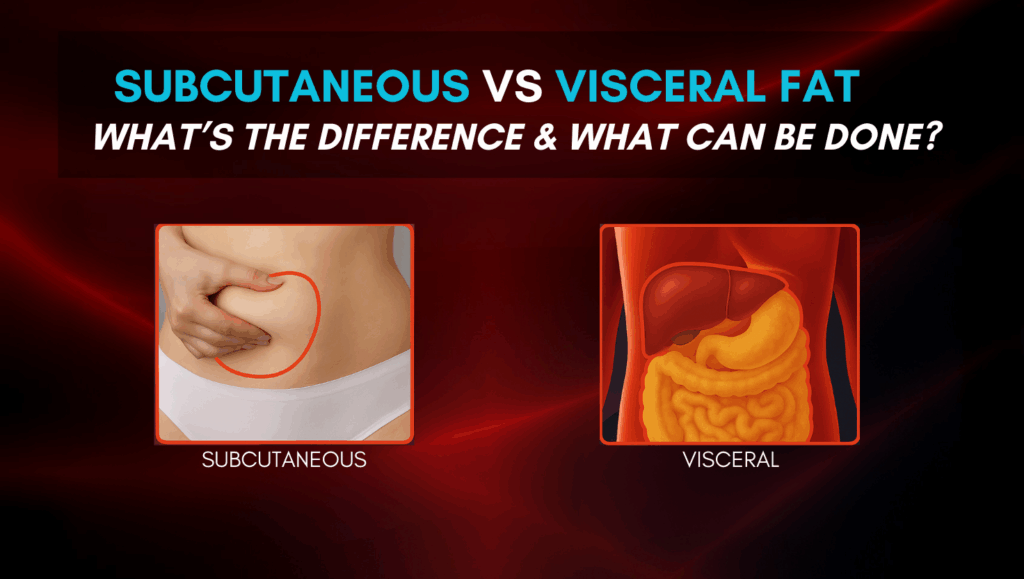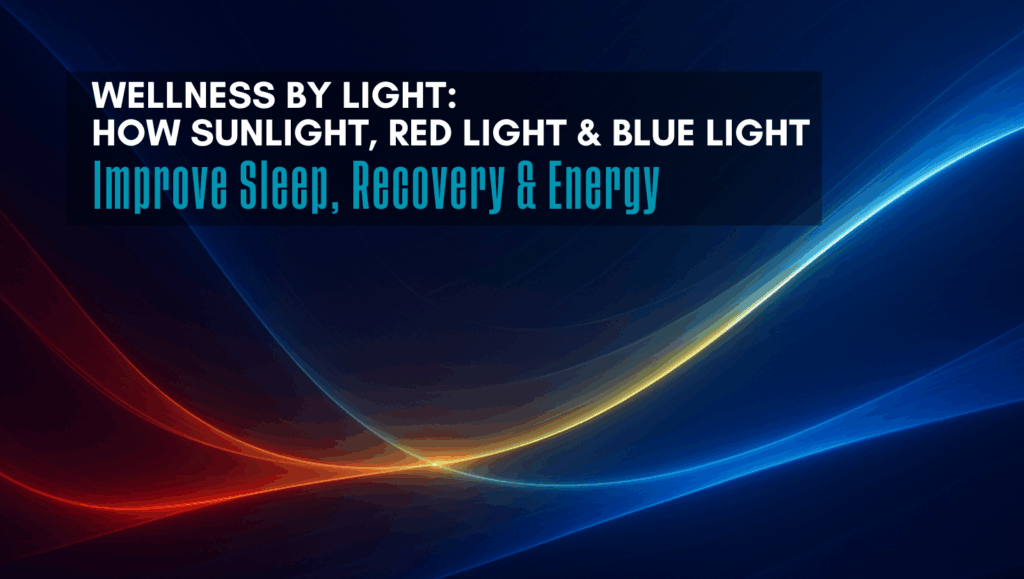Ever feel like no amount of stretching, massage, or downtime can touch that stubborn muscle pain or deep-in-your-bones stiffness? Whether you’re sore from a tough workout, dealing with arthritis, or just tired of those nagging aches that never seem to take a hint—sometimes your body needs more than the usual recovery routine.
That’s where infrared therapy steps in. It’s not just another trend—this gentle, deeply-penetrating treatment works below the surface to help your body recover faster and feel genuinely better. At Body Lab Studio, we use it to support natural healing, improve mobility, and give our clients real, lasting relief.
So what is infrared therapy, exactly—and why does it work so well? Let’s take a closer look.

What Is Infrared Therapy?
Infrared therapy is a form of heat treatment that works deeper than the surface—reaching into muscles, joints, and tissues to help your body heal from the inside out. Unlike traditional methods that only warm the skin, infrared light penetrates below it, delivering targeted, lasting relief.
Here’s how it supports recovery:
- Boosts circulation – Increases the flow of oxygen-rich blood to sore or stiff areas, which helps speed up the healing process.
- Reduces inflammation – Calms irritated muscles and swollen joints without the need for medication.
- Relieves pain naturally – Delivers deep, consistent warmth that eases discomfort where it starts.
The light itself is invisible to the eye, but the results are hard to miss. Whether you’re managing everyday soreness or chronic issues like arthritis, infrared therapy offers a simple, drug-free way to feel better—one session at a time.
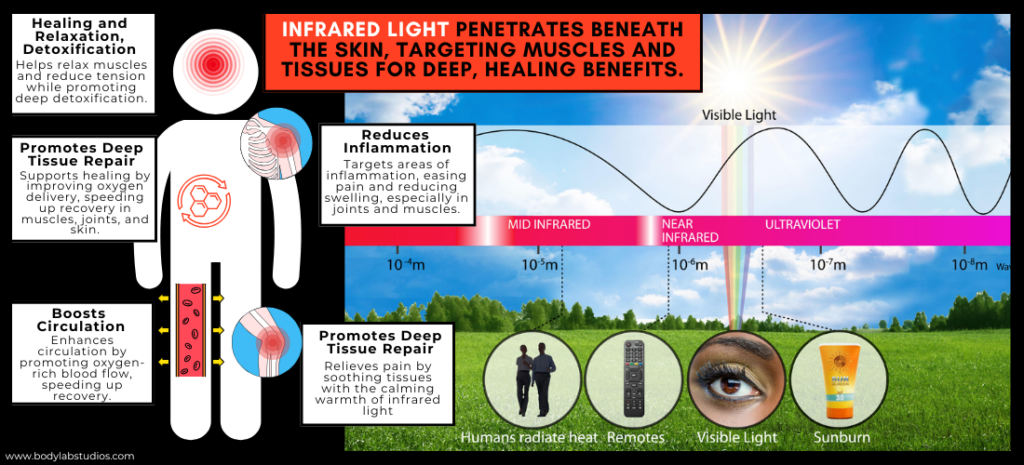
Key Benefits of Infrared
Infrared therapy isn’t just about kicking back and relaxing—though that part’s nice. It’s a smart, low-effort way to help your body recover, recharge, and move better. Whether you’re managing chronic pain, stubborn joint stiffness, or that post-workout soreness that won’t quit, this non-invasive treatment can quietly work wonders behind the scenes.
1. Chronic Pain Relief
Struggling with that stubborn back pain that just won’t quit? Or maybe it’s those stiff, aching joints that greet you every morning like clockwork. You’re not imagining things—and thankfully, you’re not out of options either. Research by Gale et al. (2006) showed that infrared therapy can make a real difference, especially for chronic low back pain. Patients actually reported feeling noticeably better after treatment.
The science behind it? Infrared therapy boosts circulation and eases inflammation, which helps calm down everything from arthritis flare-ups to fibromyalgia discomfort and everyday muscle tension. It’s a quiet kind of relief—but the kind that sticks around.
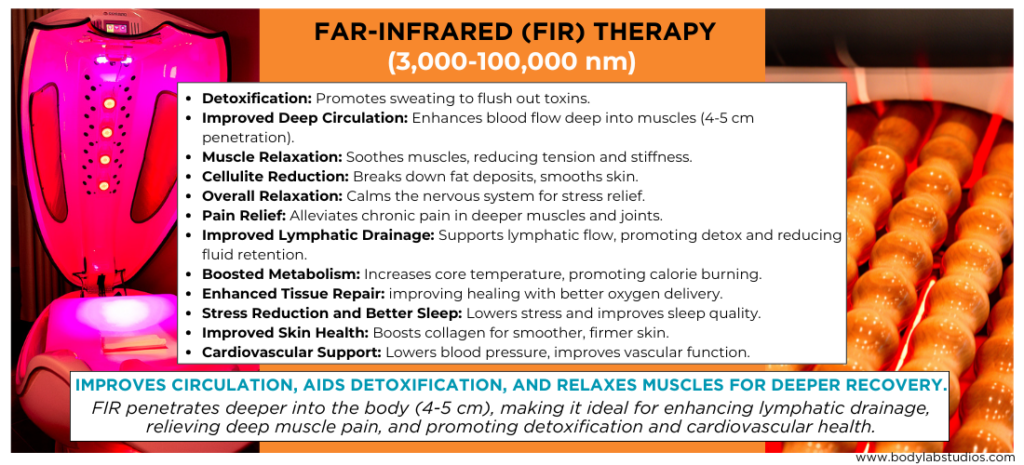
2. Muscle & Joint Recovery
Ever finish a workout and feel like your muscles just… aren’t on the same page as the rest of you? Infrared therapy can help speed things along. By boosting circulation, it delivers more oxygen and nutrients right where your body needs them—helping sore areas recover faster and cutting down on that sluggish, weighed-down feeling.
And it’s not just for post-gym aches. A 2022 systematic review (Tsagkaris et al.) found that infrared therapy can ease pain from conditions like osteoarthritis and fibromyalgia. In other words, it’s not just about feeling better—it’s about moving better, too.
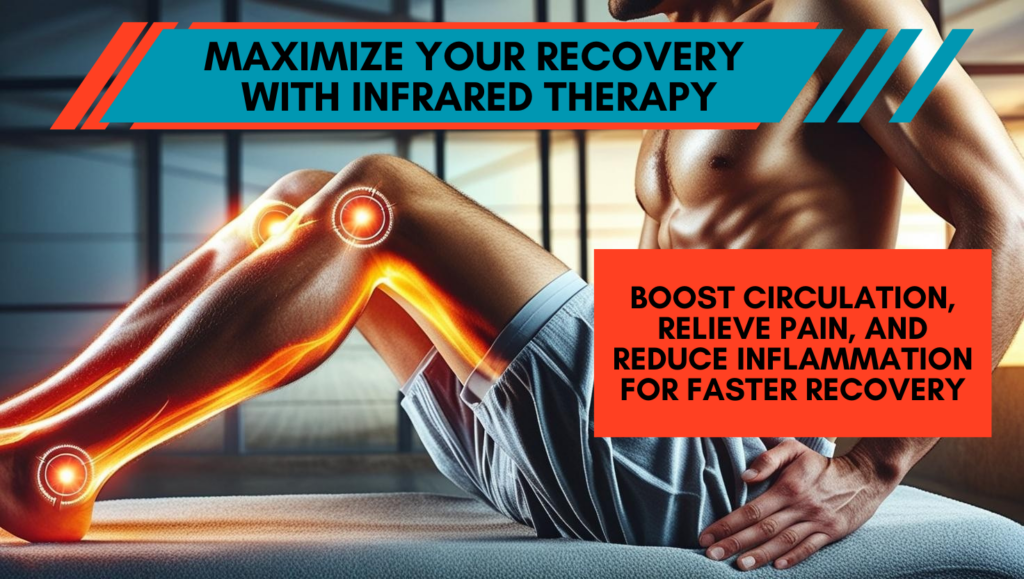
3. Joint Health & Flexibility
Stiff knees acting up again? Maybe it’s that old injury that never quite went away. Infrared therapy might be worth a second look—it’s been shown to ease pain and inflammation in people with osteoarthritis (Barry et al., 2022). It works by boosting circulation and encouraging cellular repair, which can do wonders for keeping your joints moving the way they should. In the long run, it’s not just about feeling better now—it’s about staying ahead of that creeping stiffness that likes to show up uninvited.
What Does Infrared Therapy Feel Like?
If you’ve never tried infrared therapy before, you might be curious what it actually feels like. The good news? It’s about as low-effort and high-reward as it gets. No poking, prodding, or pressure—just gentle, soothing heat that does all the heavy lifting for you.
Picture this: you’re lying back, wrapped in a warm, almost cocoon-like glow. There’s no intense pressure like with a deep-tissue massage, no needles or cracking joints—just a quiet, radiant heat that slowly seeps into your muscles and joints. Many people say it feels like a softer, more breathable version of a sauna—without the overwhelming, can’t-breathe kind of heat.
As your session goes on, you might notice your muscles softening, your joints loosening up, and a general wave of calm rolling in. Some folks even zone out into a meditative state—nothing forced, it just happens. And the best part? Because infrared works from the inside out, the benefits tend to stick around long after you’ve walked out the door.
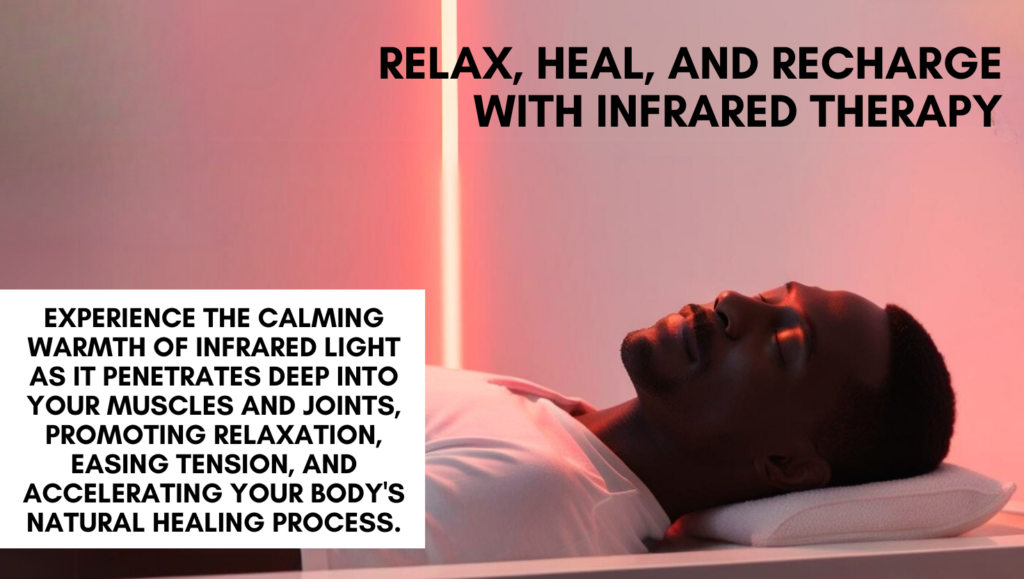
The Science Behind Infrared Therapy
Infrared therapy isn’t just a feel-good trend—it’s grounded in real science with real benefits. When infrared light penetrates the skin, it travels deep into your muscles, joints, and connective tissues. That’s where the magic starts: increased blood flow, reduced inflammation, and a gentle nudge to your body’s natural healing response. It’s like giving your system a subtle reset, minus the drama.
If your body’s been asking for a little extra care lately, this might be the answer. Book a session at Body Lab Studio and see what the science feels like in real life.
REFERENCE
- Gale, G. D., Rothbart, P. J., & Li, Y. (2006). Infrared therapy for chronic low back pain: A randomized, controlled trial. Pain Research & Management, 11(3), 193–196. In this study, 40 patients with chronic low back pain were randomly assigned to IR therapy or placebo groups over seven weeks. The treatment group experienced a significant reduction in pain scores from 6.9 to 3.0 on a 10-point scale, while the placebo group showed a decrease from 7.4 to 6.0. No adverse effects were reported, suggesting IR therapy’s effectiveness in reducing chronic low back pain.
- Tsagkaris, C., Papazoglou, A. S., Eleftheriades, A., Tsakopoulos, S., Alexiou, A., Găman, M.-A., & Moysidis, D. V. (2022). Infrared radiation in the management of musculoskeletal conditions and chronic pain: A systematic review. European Journal of Investigation in Health, Psychology and Education, 12(3), 334–343. This systematic review analyzed 13 studies focusing on IR therapy’s effects on conditions like osteoarthritis and fibromyalgia. Findings indicated a decrease in pain levels, as measured by the visual analog scale, and improved Fibromyalgia Impact Questionnaire scores. However, IR therapy did not significantly aid muscle recovery post-athletic injuries. mdpi.com
- Barry, M. A., Pérez-Campos, E., Navarro, L. M. S., Mayoral, L. P. C., Hernández-Huerta, T., Canseco, S. P., Jerónimo, J. H., & Zarate, C. M. (2022). Effects of infrared radiation in the treatment of patients with knee osteoarthritis: A systematic review. South Florida Journal of Development, 3(4), 5365–5374. This review concluded that IR therapy is a reliable and effective method for treating osteoarthritis, demonstrating positive effects in reducing knee pain and inflammation. ojs.southfloridapublishing.com
- Emshoff, R., Bösch, R., Pümpel, E., Schöning, H., & Strobl, H. (2008). Low-level laser therapy for treatment of temporomandibular joint pain: A double-blind and placebo-controlled trial. Oral Surgery, Oral Medicine, Oral Pathology, Oral Radiology, and Endodontology, 105(4), 452–456. This double-blind, placebo-controlled trial assessed low-level laser therapy’s impact on temporomandibular joint pain. Results showed significant pain reduction in the treatment group compared to placebo, supporting IR therapy’s potential in managing temporomandibular disorders.
These studies collectively suggest that IR therapy can be an effective complementary treatment for various chronic pain and inflammatory conditions, though its efficacy may vary depending on the specific ailment.

